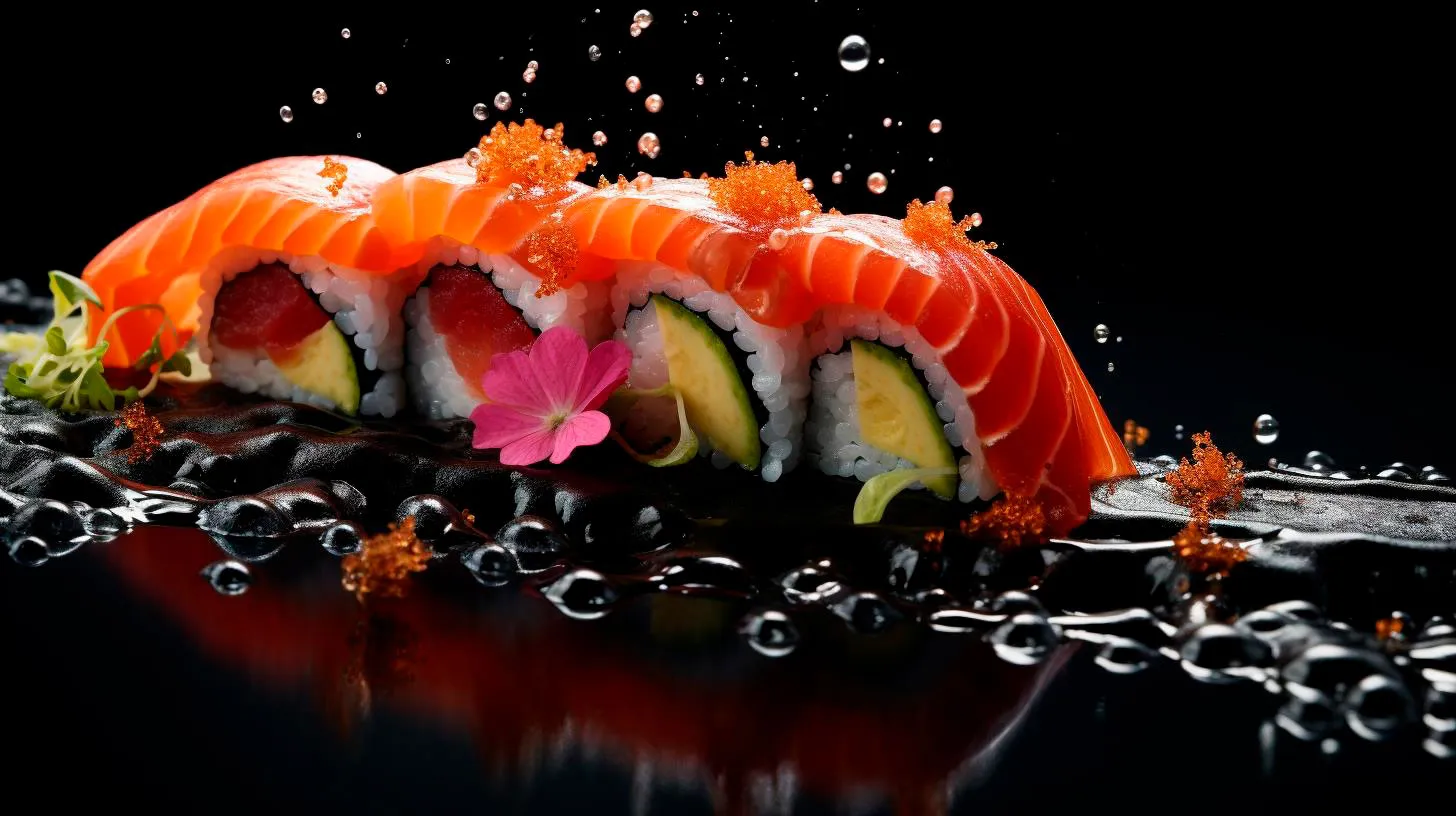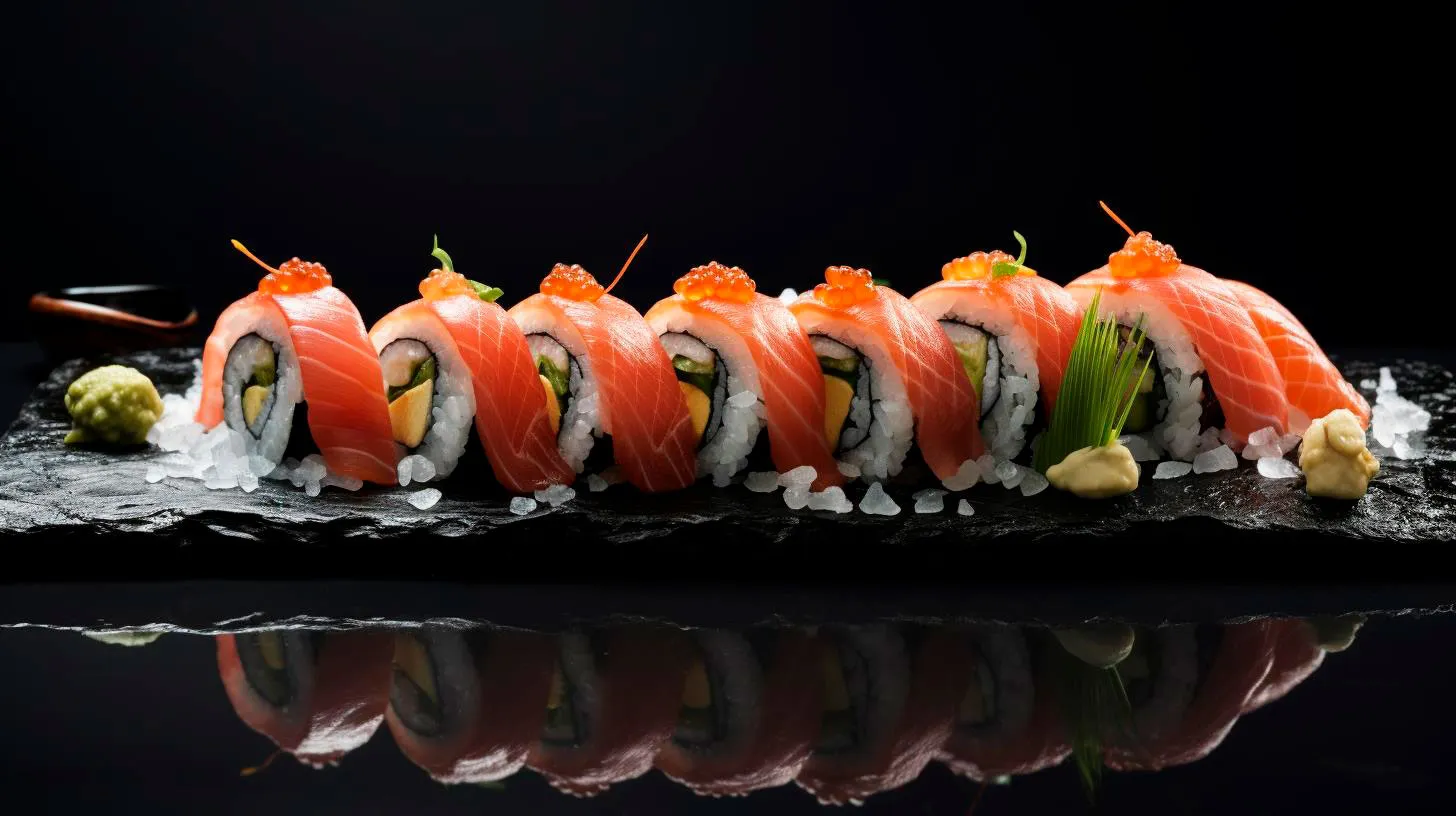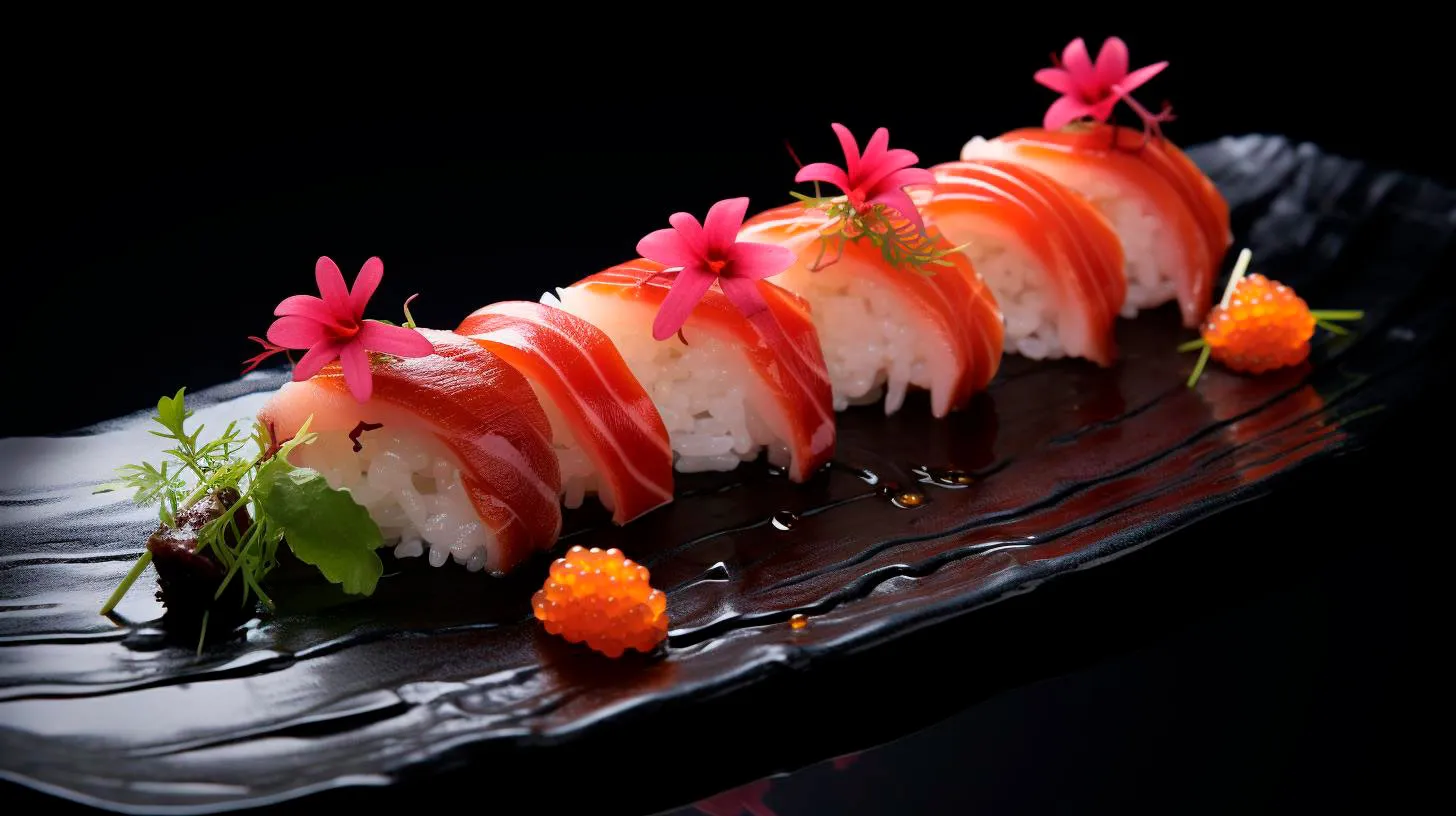Designing Gluten-Free Sushi
In this article, we will explore the art of designing gluten-free sushi and discuss the challenges and opportunities it presents.
Understanding Gluten and its Relevance to Sushi
Gluten is a protein found in several grains such as wheat, barley, and rye. People with gluten intolerance or celiac disease experience adverse reactions when consuming gluten. Traditionally, sushi contains soy sauce, which is often made using wheat. This poses a challenge for individuals on gluten-free diets who wish to enjoy sushi without compromising their health.
Key Takeaway: Creating gluten-free sushi requires replacing or eliminating ingredients that contain gluten to ensure the final product is safe for consumption.
Challenges in Designing Gluten-Free Sushi
1. Rice Vinegar Selection:
Rice vinegar is an essential component in sushi rice. Some rice vinegars may contain trace amounts of gluten due to cross-contamination during production. It is crucial to select a gluten-free rice vinegar brand that explicitly labels its product as gluten-free.
2. Soy Sauce Substitute:
Traditional soy sauce is typically made using wheat. However, numerous gluten-free soy sauce alternatives are available in the market. These options use gluten-free grains like rice or tamari sauce, which is made without wheat. By substituting traditional soy sauce with gluten-free alternatives, sushi chefs can ensure their creations are safe for gluten-sensitive individuals.
3. Gluten-Free Sushi Fillings:
Creating appetizing gluten-free sushi fillings requires careful ingredient selection. Some common sushi fillings, such as tempura, may contain wheat-based flours. By replacing tempura with gluten-free breadcrumb coatings or exploring alternative fillings like avocado, cucumber, or fresh seafood, sushi chefs can cater to gluten-free requirements while maintaining flavor and texture.
Key Takeaway: Overcoming the challenges of designing gluten-free sushi involves selecting gluten-free rice vinegar, using gluten-free soy sauce substitutes, and carefully choosing fillings that are free from gluten-containing ingredients.
Opportunities in Gluten-Free Sushi Design
Designing gluten-free sushi presents an excellent opportunity for sushi restaurants and chefs to cater to a wider customer base. By offering gluten-free sushi options, these establishments can attract individuals with gluten intolerance or celiac disease who may have previously hesitated to dine out.
Advantages of Designing Gluten-Free Sushi:
- Health-Conscious Audience: With the increasing interest in healthier eating habits, gluten-free sushi appeals to health-conscious individuals who want to enjoy Japanese cuisine without compromising their dietary restrictions.
- Expanding Customer Base: By accommodating gluten-free requirements, sushi restaurants have the potential to attract new customers who appreciate the efforts taken to provide safe and delicious options.
- Enhanced Reputation: By offering a diverse menu that includes gluten-free sushi, restaurants can build a reputation for inclusivity and thoughtfulness towards customer needs.
Key Takeaway: Creating gluten-free sushi not only opens up opportunities to target a niche market but also enhances the reputation and customer base of sushi restaurants.
Incorporating Gluten-Free Sushi Design in Menus
When introducing gluten-free sushi options on a menu, it is essential to clearly indicate which items are gluten-free to avoid any confusion or potential cross-contamination issues. Here are some effective ways to incorporate gluten-free sushi design in menus:
1. Specify Gluten-Free Items:
Labeling sushi rolls or menu sections as “gluten-free” helps customers identify suitable options. This increases their confidence in selecting gluten-free sushi and ensures a positive dining experience.
2. Train Sushi Chefs:
Providing proper training to sushi chefs regarding gluten-free requirements is crucial. They should be aware of potential cross-contamination risks and understand which ingredients to use or avoid when preparing gluten-free sushi.
3. Collaborate with Gluten-Free Suppliers:
Working with trusted gluten-free ingredient suppliers can ensure a consistent supply of high-quality gluten-free products. Collaboration with such suppliers also supports local businesses in the gluten-free industry.
Key Takeaway: Incorporating gluten-free sushi design in menus involves clearly labeling gluten-free items, training sushi chefs in gluten-free practices, and collaborating with reliable gluten-free suppliers.
Conclusion
Designing gluten-free sushi presents both challenges and opportunities for sushi chefs and restaurants. By understanding the dietary restrictions and carefully selecting suitable ingredients, sushi chefs can create delicious and safe gluten-free sushi options. With the increasing demand for gluten-free alternatives, offering these options can attract a wider customer base and enhance the reputation of sushi restaurants in delivering inclusive dining experiences. So, the next time you’re craving sushi but need a gluten-free option, rest assured that talented sushi chefs have you covered!
Tips for Gluten-Free Sushi Design
Thankfully, many sushi restaurants and chefs have started offering gluten-free options to cater to these dietary needs.
In this article, we will explore some valuable tips for designing gluten-free sushi that is both delicious and safe to consume. Whether you’re a sushi lover who needs to avoid gluten or a chef looking to accommodate gluten-sensitive customers, these tips will help you create a memorable gluten-free sushi experience.
Gluten-Free Ingredients for Sushi
When it comes to making gluten-free sushi, the key is to choose ingredients that are naturally gluten-free. Here are some great options:
- Nori (Seaweed): Nori is an essential ingredient used to wrap sushi rolls. It is gluten-free and adds a distinct flavor to the sushi.
- Sushi Rice: Sushi rice is typically made with short-grain rice and vinegar. While vinegar sometimes contains gluten, alternatives like rice vinegar or gluten-free vinegar can be used to ensure the rice remains gluten-free.
- Fillings: The options for gluten-free fillings in sushi are endless. From fresh vegetables like cucumber and avocado to proteins like cooked fish, shrimp, or tofu, there are plenty of gluten-free choices to explore.
- Gluten-Free Soy Sauce: Many supermarkets now offer gluten-free soy sauce options, which can be used sparingly as a dipping sauce or added to rolls for an extra burst of flavor.
Designing Gluten-Free Sushi Rolls
Creating visually appealing sushi rolls is an art form that requires careful consideration. Here are some tips to help you design gluten-free sushi rolls that are both aesthetically pleasing and delicious:
1. Play with Colors
Use a variety of colorful vegetables and proteins to create visual appeal. Bright peppers, carrots, and fish will not only add vibrancy but also enhance the taste of your sushi rolls.
2. Experiment with Fillings
Don’t be afraid to think outside the box and experiment with different fillings. Unique combinations of flavors like mango and shrimp, or sweet potato and avocado, can create a memorable sushi experience.
3. Master the Art of Rolling
Rolling sushi can be challenging, but practice makes perfect. Ensure that your rolls are tightly wrapped to prevent them from falling apart. A sushi mat can be incredibly helpful in achieving the perfect roll.
4. Garnish Wisely
Add a finishing touch to your gluten-free sushi rolls with beautiful garnishes. Fresh herbs like cilantro or thinly sliced fruits like strawberries can add a pop of color and flavor.
The Advantages of Gluten-Free Sushi
Gluten-free sushi offers several advantages for both consumers and restaurateurs. Consider the following benefits:
- Dietary Accommodation: By offering gluten-free sushi, restaurants can accommodate a broader range of dietary needs, attracting more customers and increasing customer satisfaction.
- Expanding Customer Base: There is a growing demand for gluten-free options due to the increasing prevalence of gluten sensitivities and celiac disease. Providing gluten-free sushi can help capture this market.
- Health-Conscious Choice: Many individuals with gluten sensitivities are also health-conscious. By opting for gluten-free sushi, they can enjoy a flavorful meal without compromising their dietary restrictions.
Key Takeaways
Gluten-free sushi is a popular choice for those who are gluten-sensitive or have celiac disease. By using gluten-free ingredients and following some design tips, you can create visually stunning sushi rolls that are safe to consume. Remember these key takeaways:
- Choose gluten-free ingredients like nori, sushi rice, and fillings.
- Experiment with colors, fillings, and garnishes to create visually appealing sushi rolls.
- Gluten-free sushi helps accommodate dietary needs and expands the customer base.
By incorporating these tips into your sushi-making repertoire, you can ensure that everyone can enjoy a delightful gluten-free sushi experience.
The Art of Gluten-Free Sushi
In this article, we will explore the art of gluten-free sushi and delve into some of the delicious alternatives available.
Understanding Gluten-Free Sushi
Gluten-free sushi is specifically created for individuals who have dietary restrictions due to celiac disease or gluten sensitivity. While traditional sushi rolls are off-limits due to the use of regular soy sauce and wheat-based ingredients, gluten-free versions offer a safe and equally delicious alternative.
Key features and advantages of gluten-free sushi:
- Uses gluten-free soy sauce: Traditional soy sauce contains wheat, which is a gluten-containing grain. Gluten-free soy sauce is made using tamari, a gluten-free alternative made from fermented soybeans.
- Alternative wrapping options: Instead of the usual seaweed wrap, gluten-free sushi can utilize cucumber, soy paper, or even thinly sliced vegetables as a substitute.
- Gluten-free fillings: Gluten-free sushi is filled with a variety of ingredients that do not contain gluten, such as fresh fish, avocado, cucumber, and other vegetables.
The Rise of Gluten-Free Sushi
The demand for gluten-free options in the food industry has been on the rise in recent years. According to a report by Global Market Insights, the global gluten-free product market is projected to reach $32 billion by 2026, driven by the increasing prevalence of gluten-related disorders and the growing adoption of gluten-free diets.
This growing trend has encouraged sushi chefs to develop innovative ways to cater to those with gluten sensitivities. The introduction of gluten-free soy sauce and alternative wrapping options has made it possible for sushi enthusiasts to enjoy this beloved cuisine without compromising their health.
Mastering the Art of Gluten-Free Sushi
To create a delectable gluten-free sushi roll, several key considerations must be kept in mind. Here are some tips to help you master the art of gluten-free sushi:
1. Use gluten-free ingredients
Ensure that all the ingredients and condiments used in making your sushi rolls are gluten-free. This includes soy sauce, vinegar, wasabi, and pickled ginger. Double-checking the labels can save you from any potential gluten-related mishaps.
2. Explore alternative wrapping options
Experiment with different wrapping options such as cucumber, soy paper, or thinly sliced vegetables. Not only do these alternatives add a unique crunch to your sushi, but they also make it completely gluten-free.
3. Opt for fresh, high-quality fish and vegetables
The quality of your ingredients is crucial to creating outstanding gluten-free sushi. Choose fresh, sustainably sourced fish and vegetables to enhance the flavors of your rolls. Farmers’ markets and local seafood suppliers are great places to find the best quality ingredients.
4. Master the rolling technique
Rolling sushi can be a delicate process, especially when using alternative wrapping options. Practice your rolling technique to ensure that your sushi rolls are well-formed and hold together tightly.
Key Takeaways
- Gluten-free sushi offers a safe and delicious option for those with gluten sensitivities.
- Gluten-free sushi uses alternative wrapping options and gluten-free soy sauce.
- The demand for gluten-free options in the food industry is on the rise.
- Gluten-free sushi can be made using fresh, high-quality ingredients.
- Mastering the art of gluten-free sushi involves using gluten-free ingredients and practicing the rolling technique.
With the increasing prevalence of gluten sensitivities, the availability of gluten-free sushi has become essential for sushi enthusiasts. By choosing gluten-free options and mastering the art of gluten-free sushi, individuals can indulge in this beloved cuisine while prioritizing their health.
Sushi Presentation Tips: Elevating the Art of Food
The Importance of Sushi Presentation
Sushi presentation goes beyond simply arranging the ingredients on a plate. It is an art form that showcases the creativity and attention to detail of the sushi chef. When done right, it not only enhances the visual appeal but also stimulates the appetite of the diners. A well-presented sushi masterpiece is not only pleasing to the eye but also sets the expectation for a delightful culinary experience.
Key Tips for Sushi Presentation
1. Use Fresh and Vibrant Ingredients
The quality of the ingredients is paramount when it comes to sushi. Fresh fish, crisp vegetables, and vibrant garnishes not only make the sushi visually appealing but also greatly impact the taste. Use seasonal ingredients to add variety and ensure the flavors are at their peak.
2. Play with Colors and Textures
Add a pop of color and texture to your sushi presentation. Incorporate different colored vegetables like carrot, cucumber, or avocado to create a visually striking dish. Consider using contrasting textures such as crispy tempura or creamy sauce to add depth and intrigue to the plate.
3. Master the Art of Knife Skills
The precision and finesse in knife skills can make a significant difference in sushi presentation. A skilled sushi chef knows how to cut the fish to achieve the perfect thickness and shape. Pristine slices of fish not only look visually appealing but also ensure a consistent flavor and texture in every bite.
4. Plate Presentation Techniques
Experiment with different plating techniques to make your sushi dish stand out. From classic rectangular plates to modern ceramic dishes, choose a plate that complements the style of your sushi. Use negative space strategically to allow the sushi to take center stage. Additionally, garnish the plate with edible flowers, microgreens, or wasabi leaves to add an elegant touch.
Advantages of Well-Presented Sushi
- Enhanced Dining Experience: Aesthetically pleasing sushi not only elevates the taste but also enhances the overall dining experience for customers.
- Higher Perceived Value: Well-presented sushi is often associated with quality and craftsmanship, allowing restaurants to charge a premium.
- Social Media Buzz: Instagram-worthy sushi presentations have gained immense popularity, providing free advertising and exposure for the restaurant.
- Customer Satisfaction: When a sushi dish is presented with care and creativity, it shows the commitment of the chef towards delivering exceptional food.
Key Takeaways
Sushi presentation is an art form that can elevate the dining experience to new heights. By using fresh ingredients, playing with colors and textures, mastering knife skills, and utilizing plate presentation techniques, you can create visually stunning sushi dishes that captivate both the eyes and taste buds of your customers.
Remember, in the world of sushi, presentation matters. Let your creativity shine and take your sushi to a whole new level!



